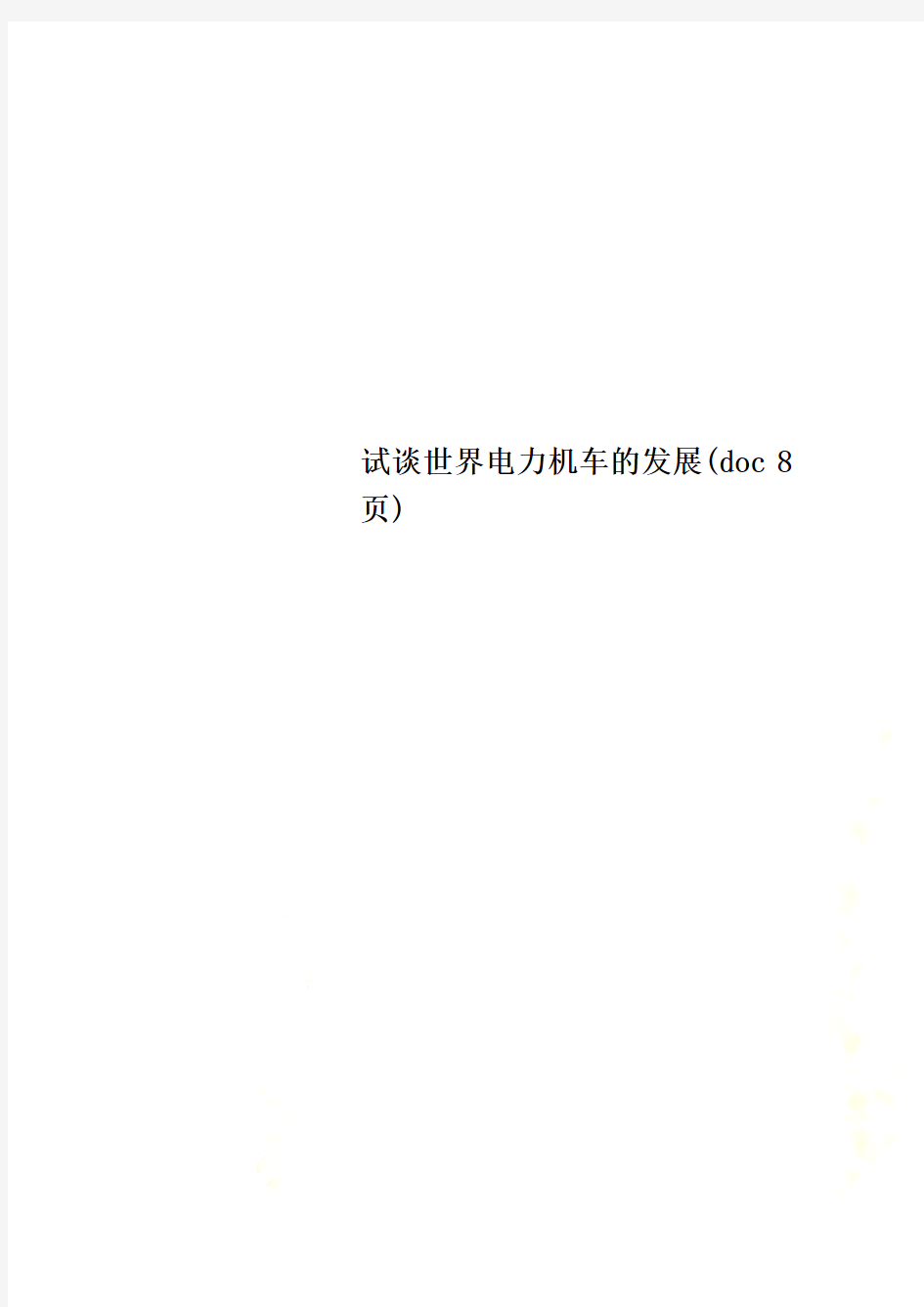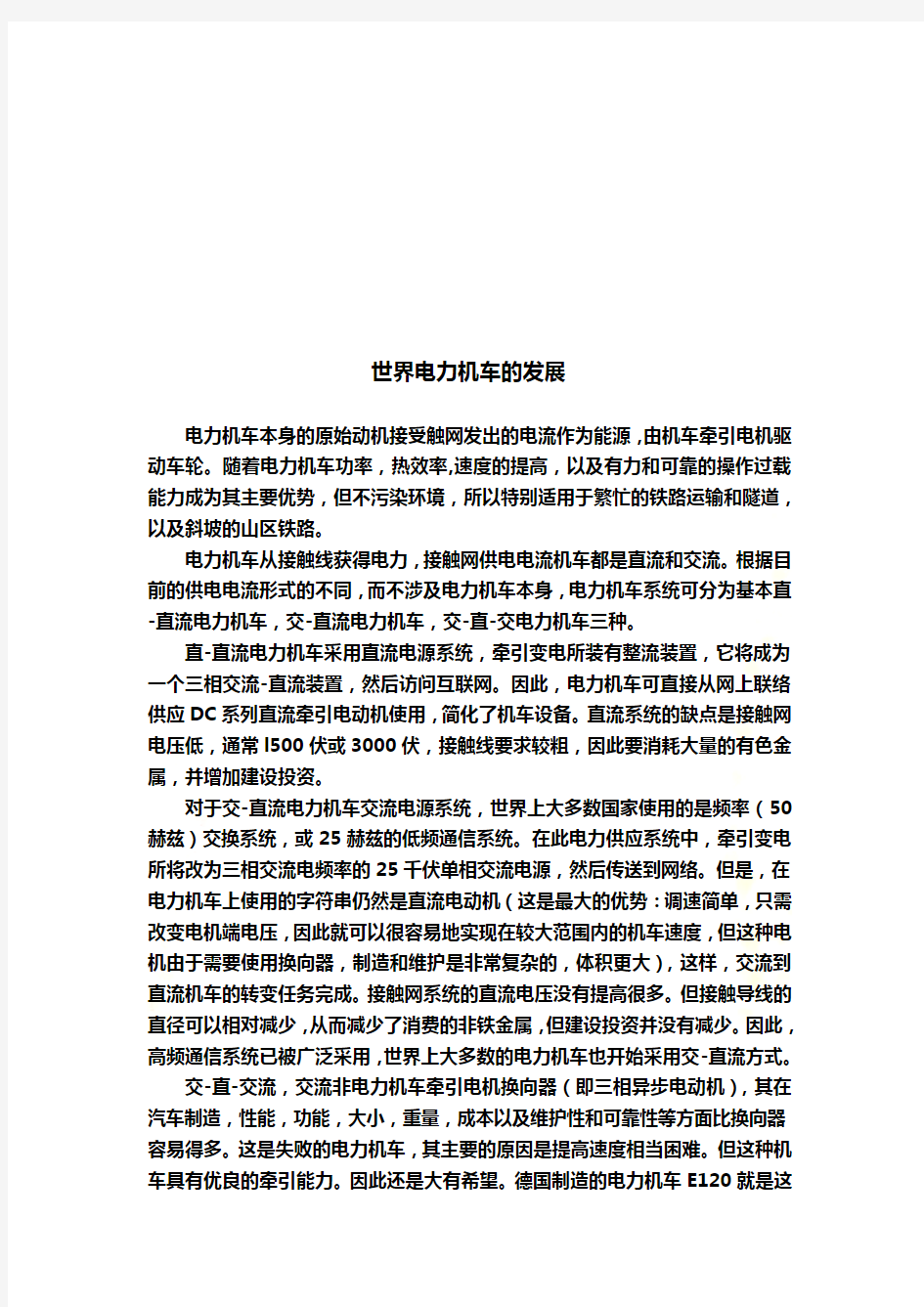试谈世界电力机车的发展(doc 8页)


试谈世界电力机车的发展(doc 8页)
世界电力机车的发展
电力机车本身的原始动机接受触网发出的电流作为能源,由机车牵引电机驱动车轮。随着电力机车功率,热效率,速度的提高,以及有力和可靠的操作过载能力成为其主要优势,但不污染环境,所以特别适用于繁忙的铁路运输和隧道,以及斜坡的山区铁路。
电力机车从接触线获得电力,接触网供电电流机车都是直流和交流。根据目前的供电电流形式的不同,而不涉及电力机车本身,电力机车系统可分为基本直-直流电力机车,交-直流电力机车,交-直-交电力机车三种。
直-直流电力机车采用直流电源系统,牵引变电所装有整流装置,它将成为一个三相交流-直流装置,然后访问互联网。因此,电力机车可直接从网上联络供应DC系列直流牵引电动机使用,简化了机车设备。直流系统的缺点是接触网电压低,通常l500伏或3000伏,接触线要求较粗,因此要消耗大量的有色金属,并增加建设投资。
对于交-直流电力机车交流电源系统,世界上大多数国家使用的是频率(50赫兹)交换系统,或25赫兹的低频通信系统。在此电力供应系统中,牵引变电所将改为三相交流电频率的25千伏单相交流电源,然后传送到网络。但是,在电力机车上使用的字符串仍然是直流电动机(这是最大的优势:调速简单,只需改变电机端电压,因此就可以很容易地实现在较大范围内的机车速度,但这种电机由于需要使用换向器,制造和维护是非常复杂的,体积更大),这样,交流到直流机车的转变任务完成。接触网系统的直流电压没有提高很多。但接触导线的直径可以相对减少,从而减少了消费的非铁金属,但建设投资并没有减少。因此,高频通信系统已被广泛采用,世界上大多数的电力机车也开始采用交-直流方式。
交-直-交流,交流非电力机车牵引电机换向器(即三相异步电动机),其在汽车制造,性能,功能,大小,重量,成本以及维护性和可靠性等方面比换向器容易得多。这是失败的电力机车,其主要的原因是提高速度相当困难。但这种机车具有优良的牵引能力。因此还是大有希望。德国制造的电力机车E120就是这
不断,到1976年,L型作出韶山(韶山Ⅰ型)第131号,已基本确立。直到1989年停止生产的最后期限,SSL电力机车共有926家台湾制造商,成为我国第一个电气化铁路主要火车头。1966列SS2机车于1978年研制成功。不仅使SS3型机车牵引性能改进,而且每小时的机车功率从200kW至4千瓦,截止到1997年底,共生产了987列,成为第一次中国两种主要的电力机车。1985年还成功地发展了SS4型8轴货运电力机车,这是我国最大功率的电力机车(6400千瓦),已成为我国主要的重型货运机车。然后又成功继承发展SS5 ,SS6和SS7型电力机车。1994年已成功地发展了速度达160公里的高速电力机车以及其他4轴电力机车。
伴随着世界潮流,诞生了新的“直-交”电力机车技术。从20世纪70年代末,我国一直在进行中小型铁路功率变换器的研究。在地面上的高功率测试也在进行中,直-交流电力机车研究也已取得初步成效。
发展我国电力机车始于1958年。在那个时候,铁道部第三机车厂,即现在的株洲电力机车厂在协助湘潭电机采矿电力机车制造工厂的同时,设计和编制铁路电力机车。
1958年年初,该部机械工业部组织第一次访问苏联考察。在那个时候,基本定型的观念是:由于苏联使用20千伏单相交流系统Н60频率电力机车,因此中方决定采取25千伏单相交流系统,并且频率各不相同。
所以Н60电力机车是一个大胆的技术改造,这相当于78个重大变化。
1958年12月28日,我国第一台电力机车研制成功的铁路干线,命名“Y1-6”,机车持续功率3410千瓦,最高速度100公里/小时。
到目前为止,我国干线电力机车已基本形成了4,6,8轴和3200千瓦,6400千瓦和4800千瓦幂级数。1999年5月26日,我国的株洲电力机车厂生产了第一个速度超过200公里DDJ1子弹头型电力机车,标志着我国电力牵引已跻身于国际高速列车服务行列。
The Development of World Electric Locomotive Electric locomotive itself with the original motive accept catenary sent by the current as a source of energy, from locomotive traction motor drive the wheels. With electric locomotive power, thermal efficiency, fast, strong and reliable operation Guozainaili major advantages, but do not pollute the environment, and particularly applicable to the busy railway transportation and tunnels, the slope of the mountain railway.
Electric locomotive from the contact line access to electricity, catenary power supply current locomotives are both DC and AC. The current system different, not
with the electric locomotive, can be divided into basically straight-DC electric locomotive, the TAC-DC electric locomotive, the TAC-Direct-AC electric locomotive three.
Straight-DC electric locomotive using DC power supply system, traction substation equipped with rectifier devices, it will become a three-phase AC DC, and then to access the Internet. Therefore, the electric locomotive can be made online directly from the contact supply DC Series traction motor use, which simplifies the locomotive equipment. DC system's weaknesses are catenary low voltage, typically l500V or 3000 V, the contact wire request is rough, it is necessary to consume a large amount of non-ferrous metals, and increased construction investment.
TAC - DC electric locomotive powered by AC system, most of the world's countries use the frequency (50Hz) exchange system, or 25 Hz low-frequency communication system. In this supply system, traction substation will be changed to three-phase alternating current frequency of 25 kV single-phase AC power industry after exposure to the Internet. But in the electric locomotive used on the string is still DC motor (which is the biggest advantage motor speed as simple as changing motor terminal voltage, it should be easy to achieve in the larger context of the locomotive speed, but such Motor due to the commutator, manufacturing and maintenance are very complex, and also greater volume), the AC into DC locomotive in the task completed. The catenary system DC voltage than to raise a lot of contact wire diameter can be relatively reduced, reducing the consumption of non-ferrous metals and construction investment did not. Therefore, the frequency communication system has been widely adopted by majority of the world's electric locomotive also pay - DC electric locomotive.
TAC-Direct-exchange by exchange of non-electric locomotive traction motor commutator (that is, three-phase asynchronous motors),which is in the motor manufacturing, performance, functionality, size, weight, cost, maintenance and reliability and so on than the motor commutator much easier. It is the failure of the electric locomotive, is the main reason for speed rather difficult. This locomotive has excellent traction capacity promising. German-made electric locomotive E120 This is the locomotive.
The working principle of electric locomotive, the current contact wire, and withstand electric locomotive into the arch after re-entering the circuit breaker after the main transformer, AC traction from the main transformer winding through
silicon rectifier units, divided into two groups of six parallel to the traction motor DC supply concentrate to a traction motor torque, the mechanical energy into electric energy through the transmission gear-driven locomotive drive wheels turning.
The development of electric locomotives:
The first to create the first standard gauge electric locomotive is the Scots R Davidson, time is 1842. May 1879, the German Siemens W V design and manufacture of a 18 - to pull on the three open "passenger" electric locomotive, this is the first electric locomotive successful pilot. 1881, Paris, France at the first of electricity from overhead wires tram lines, which for the upgrade, using high-power traction motors to create the conditions: 1895, the United States in Baltimore - Ohio between 5.6 km long tunnel section DC electrified railway construction. 1903 Germany's three-phase AC electric locomotive created a 210 km per hour high-speed recording.
Electric locomotive of development depends on the development of electrified railway. Build a real sense electrified railway is first necessary to resolve how to provide high-voltage, change standard power supply problems.
Catenary locomotive current supply system, divided into DC system and the exchange of two (AC system in the single-phase AC again, three-phase AC), which called power supply standard. The frequency of the single-phase AC system to promote the development of electrified railway. 20 in the early 1970s, continental Europe and Japan in Asia is basically realized transport busy main railway electrification. 1973 ~ 1974 outbreak of the oil crisis, the national electricity and internal combustion of the railway traction re-evaluation of the economic, favored by the more electric traction. Britain is the development of the original diesel traction, but also started to attach importance to the development of electric traction. Even completely internal combustion of the United States, the voice of railway electrification also high. To the early 1980s, the world had more than 50 countries and regions to build the electrified railway, the Soviet Union's total length of electrified railway reached over 40,000 kilometers, Japan, France, West Germany have a more than 10,000 km of electrified Railway. At present, the world electrified railway has reached more than 20 million kilometres, China has also joined the more than 10,000 km of electrified railways, "senior club".
Electrified railway power supply problems are solved, the development of
